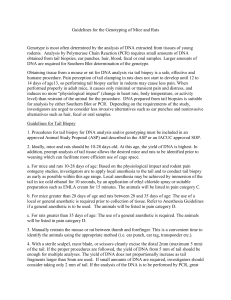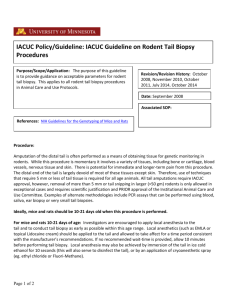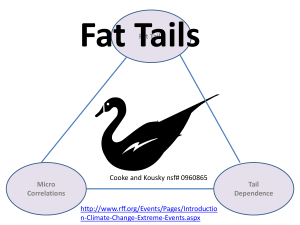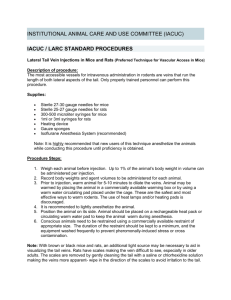Anesthesia and Analgesia for Research Animals
advertisement
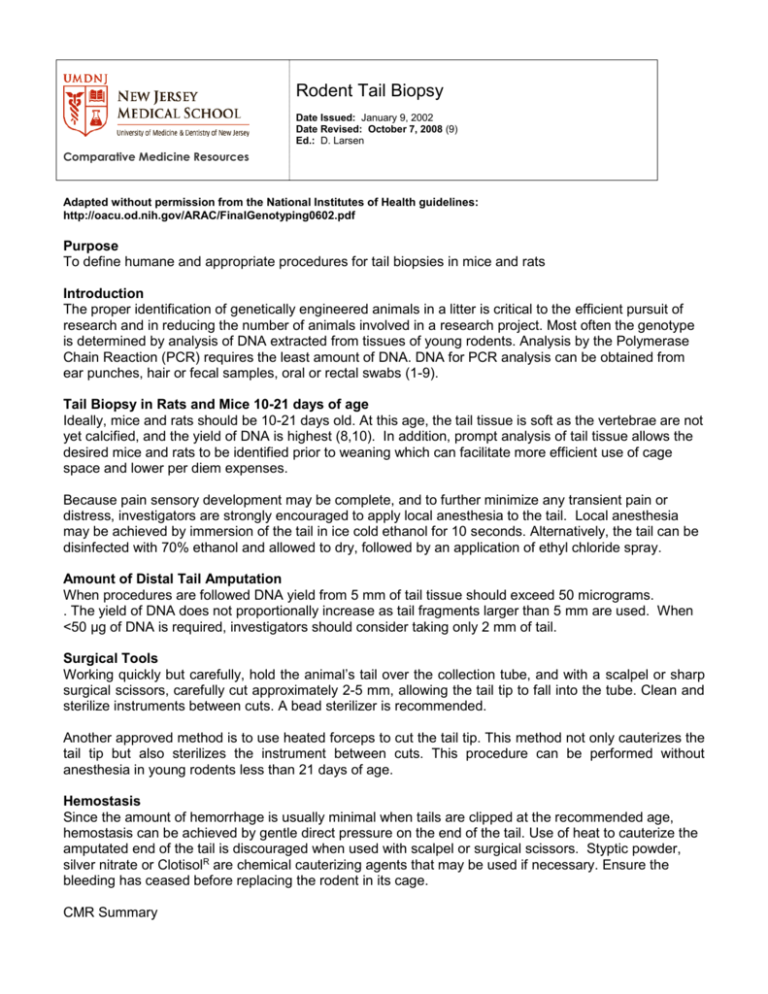
Rodent Tail Biopsy Date Issued: January 9, 2002 Date Revised: October 7, 2008 (9) Ed.: D. Larsen Comparative Medicine Resources Adapted without permission from the National Institutes of Health guidelines: http://oacu.od.nih.gov/ARAC/FinalGenotyping0602.pdf Purpose To define humane and appropriate procedures for tail biopsies in mice and rats Introduction The proper identification of genetically engineered animals in a litter is critical to the efficient pursuit of research and in reducing the number of animals involved in a research project. Most often the genotype is determined by analysis of DNA extracted from tissues of young rodents. Analysis by the Polymerase Chain Reaction (PCR) requires the least amount of DNA. DNA for PCR analysis can be obtained from ear punches, hair or fecal samples, oral or rectal swabs (1-9). Tail Biopsy in Rats and Mice 10-21 days of age Ideally, mice and rats should be 10-21 days old. At this age, the tail tissue is soft as the vertebrae are not yet calcified, and the yield of DNA is highest (8,10). In addition, prompt analysis of tail tissue allows the desired mice and rats to be identified prior to weaning which can facilitate more efficient use of cage space and lower per diem expenses. Because pain sensory development may be complete, and to further minimize any transient pain or distress, investigators are strongly encouraged to apply local anesthesia to the tail. Local anesthesia may be achieved by immersion of the tail in ice cold ethanol for 10 seconds. Alternatively, the tail can be disinfected with 70% ethanol and allowed to dry, followed by an application of ethyl chloride spray. Amount of Distal Tail Amputation When procedures are followed DNA yield from 5 mm of tail tissue should exceed 50 micrograms. . The yield of DNA does not proportionally increase as tail fragments larger than 5 mm are used. When <50 μg of DNA is required, investigators should consider taking only 2 mm of tail. Surgical Tools Working quickly but carefully, hold the animal’s tail over the collection tube, and with a scalpel or sharp surgical scissors, carefully cut approximately 2-5 mm, allowing the tail tip to fall into the tube. Clean and sterilize instruments between cuts. A bead sterilizer is recommended. Another approved method is to use heated forceps to cut the tail tip. This method not only cauterizes the tail tip but also sterilizes the instrument between cuts. This procedure can be performed without anesthesia in young rodents less than 21 days of age. Hemostasis Since the amount of hemorrhage is usually minimal when tails are clipped at the recommended age, hemostasis can be achieved by gentle direct pressure on the end of the tail. Use of heat to cauterize the amputated end of the tail is discouraged when used with scalpel or surgical scissors. Styptic powder, silver nitrate or ClotisolR are chemical cauterizing agents that may be used if necessary. Ensure the bleeding has ceased before replacing the rodent in its cage. CMR Summary Newark Research Animal Facility Standard Operating Procedures Age Required Prohibited Sample Drugs & Doses < 8 days -- Tail biopsies -- 8-21 days Hemostasis Analgesic if clinical signs of pain e.g. hunched posture, poor grooming, inappetance Local or general anesthetic Analgesic if clinical signs of pain e.g. hunched posture, poor grooming, inappetance Hemostasis Biopsies of more than 5mm of distal tail in total Buprenorphine, SQ Tail biopsies without anesthesia Local or general anesthetic Analgesic is compulsory Tail biopsies without anesthesia or analgesic immersion of the tail in ice cold ethanol for 10 seconds disinfect with 70% ethanol, allowed to dry, then topical use of ethyl chloride spray Lidocaine gel, 2%, wait 5 min Buprenorphine, SQ 22-28 days >28 days References 1. Hofstetter JR, Zhang A, Mayeda AR, Guscar, T, Nurnberger JI and Lahiri DK. Genomic DNA from Mice: A Comparison of Recovery Methods and Tissue Sources. Biochem Mol Med 1997 Dec; 62(2):197-202. 2. Dennis, MB. IACUC Review of Genetic Engineering. Lab Animal 2000 Mar; 29(3):34-37. 3. Irwin MH, Moffatt RJ and Pinkert CA. Identification of Transgenic Mice by PCR Analysis of Saliva. Nat Biotechnol 1996 Sep;14(9): 1146-8. 4. Schmitteckert EM, Prokop CM and Hedrich HJ. DNA Detection in Hair of Transgenic Mice - A Simple Technique Minimizing the Distress on the Animals. Laboratory Animals 1999; 33/4: 385-389. 5. Couse JF, Davis VL, Tally WC and Korach KS. An Improved Method of Genomic DNA Extraction for Screening Transgenic Mice. National Institute of Environmental Health Sciences, National Institutes of Health. BioTechniques 1994; 17:1030-1032. 6. Malumbres M, Mangues R, Ferrer N, Lu S and Pellicer A. Isolation of High Molecular Weight DNA for Reliable Genotyping of Transgenic Mice. BioTechniques 1997; 22/6:1114-1119. 7. Broome RL, Feng L, Zhou Q, Smith A, Hahn N, Matsui SM, Omary MB. Noninvasive Transgenic Mouse Genotyping Using Stool Analysis. FEBS Lett 1999; 462:159-160. 8. Pinkert CA. Transgenic Animal Technology: Alternatives in Genotyping and Phenotyping. Comp Med 2003; 53/2:126-139. 9. Meldgaard M, Bollen PJA, Finsen B. Non-invasive method for sampling and extraction of mouse DNA for PCR. Laboratory Animals 2004; 38:413-417. 10.Shinohara H. The Musculature of the Mouse Tail is Characterized by Metameric Arrangements of Bicipital Muscles. Okajimas Folia Anat Jpn 1999; 76-157-169 Approved - 6/12/02 2
